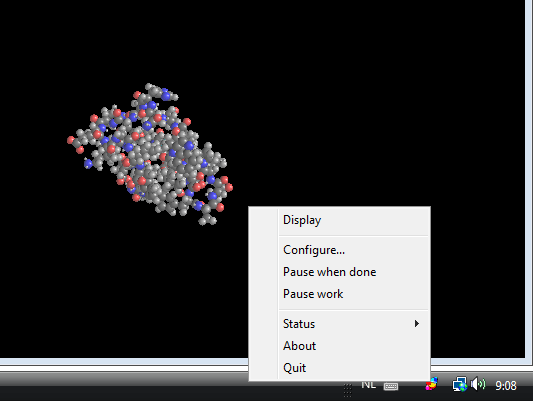7 - Folding@Home | PhysX
Folding @home on the GeForce GPU
Small sidenote here, Guru3D is ranking in the Folding@Home top 100, yes .. I'm very proud of our guys crunching these numbers, especially since there are ten's of thousands of other teams.
Now, the good news then. Over the past 12 months a lot of progress has been made between the two parties involved. And right now there is a Beta Folding client available that is working with GeForce Series 8,9 and GTX graphics processors. See, it is CUDA based .. meaning that all CUDA ready GPU's will run and can start folding.
The new GeForce GTX series will compute slightly more than 400-500 mol/day, which is three times more than the 170 mol/day of the Radeon HD 3870. To get you an even better perspective ... that's five times more than the 100 mol/day of the PlayStation 3! And that thing can crunch data man.
A shameless plug: Join Team Guru3D !
The client is out, if possible please join team Guru3D and let's fold away some nasty stuff. The good thing, you won't even notice that's running. Our folding @home info can be found here:
http://www.guru3d.com/category/folding/
For support: hop into our Folding@home support forums (click here) !
Our team number is 69411 and if you decide to purchase the GeForce GTX 280/260 product, guys, promise me you'll use it to fold for us. Of course I recommend all GeForce 8800/9800 owners to give this a try as well.
By making this move my dear friends, there are now 70 Million GPUs available to compute the biggest mysteries in deseases and illnesses. Again, let's make Team Guru3D the biggest one available guys, join our team - 69411.

GeForce PhysX aka NVIDIA PhysX
One of the newer features released a couple of weeks ago is also using CUDA. Any graphics processors (that can handle CUDA) can be utilized for NVIDIA PhysX processing - or as I like to call it - compute shaders.
You guys probably know Ageia, right? The company that brought you the physics card under the label PhysX. That company has recently been bought by NVIDIA and the good news is that PhysX as you know it is being ported, as we speak, into the graphics card driver for CUDA ready products. This means that GeForce series 8 and above now have full physics support right out of the box. So if a game supports Ageia PhysX, your Cuda ready graphics card (GeForce series 8 and above) is compatible.
In very simple wording, physics functionality will not run through the DirectX engine (DX11 will do this though), yet makes a bypass through CUDA where the Ageia PhysX API is now implemented for the bigger part. In games one can now fully utilize physics calculations. Your GPU shader engine will do the math for you.
The downside; obviously once you start using this feature you will forfeit some of the overall performance of the GPU. That's why in the future you could add your older CUDA ready graphics card as add-on and use it as the physics card while your shiny new graphics card can render the game. The idea although not definitely new, is an interesting one.
If you think that in-game physics are far away ... think again. Though a work in progress for most games, you can expect some titles to fully support the new technology and quite honestly it's pretty interesting. Any Ageia PhysX compatible game for example will work fine. On a recent editor's day we have seen a good number of titles with already full working support, one of them you guys already know. In fact the most common one was the Unreal III gaming engine; which fully supports it and we have indeed seen some examples. Gaming will become much more dynamic due to this development. Great stuff for sure.
My theory here, Ageia as a standalone company did not have a lot of chance of succeeding. Now that the technology has been integrated into NVIDIA GeForce products, it opens up a new ballgame as over 70 million GPUs worldwide can all of the sudden handle PhysX. Think about that fact for a second.
So then, in theory any CUDA enabled GPU will run Physx. Some games we already saw running using PhysX:
- Space Siege, gas powered games
- Nurien, a social network platform
- Bionic Commando, CAPCOM, GRINN
- Natural Motion, Backbreaker game
- APB Realtime worlds
- Stalker Clear Sky realtime debris - cloth
- Race driver - GRID - Phill Scott - cloth physics in flags
- Gearbox software Brother in Arms - Hells highway & Aliens: Colonial marines and Borderlands.
So while it is hard to explain what exactly physics can do in your games I will give you a few examples. Imagine cloth or flags moving fluently, dynamic created force fields with changing geometry, when you shoot at stuff, loads of debris. Another good example we have seen live in action was the Game Space siege. Imagine you are on a space ship, when you shoot at objects, they now will move along with the same speed of the ship moving; all of them. More environmentally rich sceneries loaded with for example fuel drums. You can shoot at them, they explode, move, pushing other drums away, cascading .. everything will be moving & reacting the way the programmer thinks it should. So again, this stuff is really hard to explain. Just wait and see, once the PhysX driver is finalized, go play Unreal Tournament III and check it out with and without the PhysX options. You'll notice a distinct difference.
We recently; wrote an article on GeForce Physx, you can read it here.
 Screenshot from Bionic Commando (Capcom/GRIN) - with PhysX support
Screenshot from Bionic Commando (Capcom/GRIN) - with PhysX support
